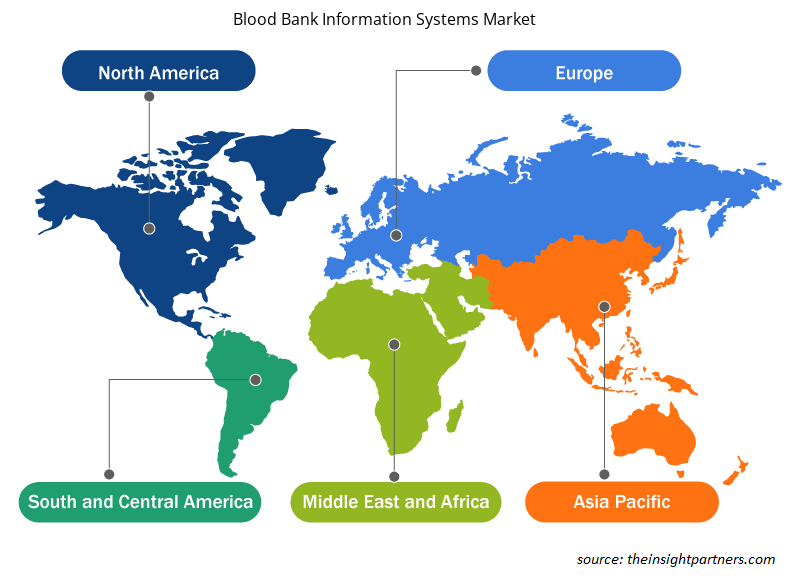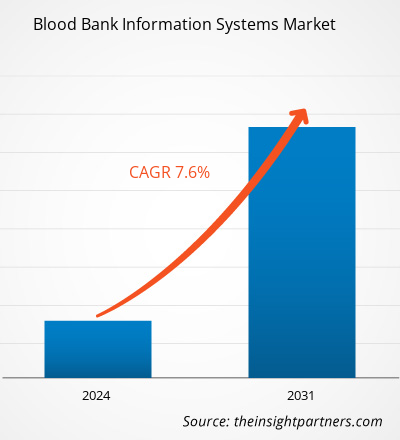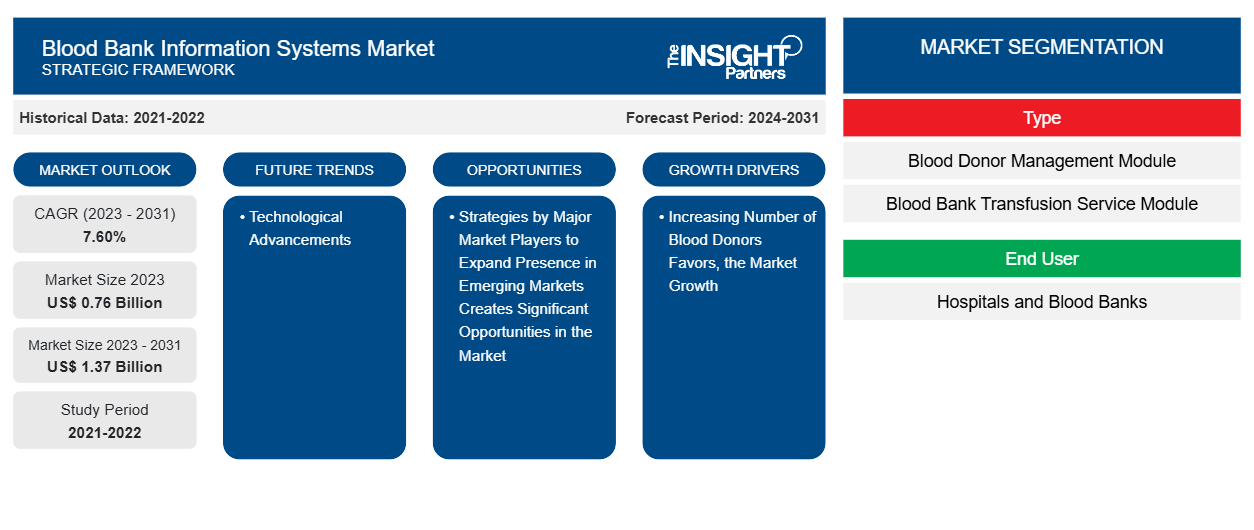La taille du marché des systèmes d'information des banques de sang devrait atteindre 1,37 milliard USD d'ici 2031, contre 0,76 milliard USD en 2023. Le marché devrait enregistrer un TCAC de 7,60 % au cours de la période 2023-2031. Les progrès technologiques devraient rester une tendance clé du marché.
Analyse du marché des systèmes d'information des banques de sang
Les entreprises s'efforcent d'introduire de nouveaux produits et d'accroître leurs opérations par diverses méthodes pour stimuler le marché. Des entreprises comme Cerner Corporation, Allscripts Healthcare, LLC, Haemonetics Corporation, WellSky, Hemosoft, Integrated Medical Systems, Soft Computer Consultants, Inc., IT Synergistics, Psyche Systems Corporation et Sunquest Information Systems, Inc. ont mis en œuvre diverses stratégies, notamment des lancements de produits, des approbations de produits, des fusions et acquisitions et des initiatives de marché. Par exemple, CliniSys a annoncé en janvier 2022 qu'elle avait récemment acquis HORIZON Lab Systems et fusionné avec Sunquest Information Systems pour devenir CliniSys.
Aperçu du marché des systèmes d'information des banques de sang
La prévalence mondiale croissante des maladies hématologiques entraîne une hausse de la demande de dons de sang. Toutes les trois minutes, aux États-Unis, une personne reçoit un diagnostic de leucémie, de lymphome ou de myélome, selon la Leukemia and Lymphoma Society (LLS). En outre, en 2021, environ 186 400 cas de leucémie, de lymphome et de myélome ont été signalés aux États-Unis. De plus, en 2021, les cas de cancer du sang représentaient environ 9,8 % des 1 898 160 nouveaux cas de cancer estimés dans le pays. Les greffes de cellules de moelle osseuse et les transfusions sanguines deviennent de plus en plus courantes en raison de l'incidence croissante des cancers du sang comme la leucémie. La Croix-Rouge américaine estime que chaque jour, environ 5 000 plaquettes, 6 500 unités de plasma et environ 29 000 unités de sang rouge sont nécessaires aux États-Unis pour divers troubles hématologiques.
En outre, 16 millions de composants sanguins sont transfusés chaque année aux États-Unis pour traiter diverses maladies liées au sang comme le cancer du sang et d’autres. De plus, il a été signalé qu’en 2020, plus de 1,8 million de personnes ont reçu un diagnostic de cancer. En conséquence, le besoin de transfusions sanguines augmente en raison de l’augmentation des maladies hématologiques, ce qui stimule la croissance du marché mondial des systèmes d’information sur les banques de sang.
Personnalisez ce rapport en fonction de vos besoins
Vous bénéficierez d'une personnalisation gratuite de n'importe quel rapport, y compris de certaines parties de ce rapport, d'une analyse au niveau des pays, d'un pack de données Excel, ainsi que de superbes offres et réductions pour les start-ups et les universités.
- Obtenez les principales tendances clés du marché de ce rapport.Cet échantillon GRATUIT comprendra une analyse de données, allant des tendances du marché aux estimations et prévisions.
Moteurs et opportunités du marché des systèmes d'information des banques de sang
Le nombre croissant de donneurs de sang favorise la croissance du marché
En raison de la fréquence accrue des accidents et de la prévalence croissante des maladies hématologiques, la demande mondiale de sang augmente. L'Organisation mondiale de la santé (OMS) estime qu'environ 118,4 millions d'unités de sang sont données dans le monde. Les pays à revenu élevé collectent 40 % de ce total. De plus, 106 millions de dons sont recensés chaque année par environ 13 300 banques de sang réparties dans 169 pays. De plus, selon l'OMS, 33 % des donneurs de sang dans le monde sont des femmes.
En outre, l’OMS a signalé qu’entre 2013 et 2018, 156 pays ont signalé une augmentation de 7,8 millions de dons de sang volontaires non rémunérés. Les régions où les augmentations des dons de sang volontaires non rémunérés sont les plus importantes sont l’Afrique (23 %) et les Amériques (25 %). Le Pacifique occidental a signalé l’augmentation la plus significative du nombre absolu de dons (2,67 millions), suivi des Amériques (2,66 millions) et de l’Asie du Sud-Est (2,37 millions). En outre, les dons de sang volontaires non rémunérés représentent plus de 90 % de l’approvisionnement en sang dans environ 79 pays, dont 38 pays à revenu élevé, 33 pays à revenu intermédiaire et huit pays à faible revenu. En outre, 62 pays s’approvisionnent en sang auprès de donneurs volontaires et non rémunérés.
En outre, plus de la moitié de l'approvisionnement mondial en sang (56 pays, neuf pays à revenu élevé, 37 pays à revenu intermédiaire et 10 pays à faible revenu) dépend de donneurs rémunérés et familiaux. Cela accroît le besoin mondial de systèmes d'information sur les banques de sang. À mesure que le nombre de donneurs de sang augmente dans le monde, les banques de sang gèrent et stockent le sang de manière nouvelle et innovante. Les systèmes d'information sur les banques de sang sont principalement utilisés pour collecter les dons de sang. Par exemple, un rapport sur le développement d'un système de récupération du sang pour aider à gérer les dossiers des donneurs de sang et à réguler la distribution du sang dans les hôpitaux publics a été publié en 2020 par Samson Oloruntoba et d'autres éditeurs. Le système offre aux dossiers des donneurs un accès rapide aux rapports médicaux de manière opportune, efficace et confidentielle. Il repose sur un système d'inventaire des dons de sang basé sur Android et le Web, qui met l'accent sur la réduction des erreurs de transfusion. Ces éléments soutiennent l'expansion du marché des systèmes d'information sur les banques de sang.Oloruntoba and other publishers. The system offers donor records quick access to medical reports in a timely, efficient, and confidential manner. Its foundation is an Android- and web-based blood donation inventory system emphasizing lowering transfusion errors. These elements support the market expansion for blood bank information systems.
Les stratégies des principaux acteurs du marché pour accroître leur présence sur les marchés émergents créent des opportunités importantes sur le marché
En raison du nombre croissant de donneurs de sang en Asie-Pacifique et en Amérique du Sud et centrale, les acteurs du marché des systèmes d'information sur les banques de sang planifient leur croissance dans plusieurs domaines. L'apprentissage profond a démontré des performances prometteuses dans la gestion du sang en utilisant des systèmes de gestion des donneurs de sang traditionnels et des modules de services de transfusion de banques de sang. Dernièrement, le système d'information sur les banques de sang a attiré beaucoup d'attention de la recherche. Dans les années à venir, on prévoit que de nombreuses entreprises, dont WellSky, Sunset Information Systems, Blood Bank de SCC Soft Computer et Allscripts Healthcare Solutions, continueront de se développer sur ces marchés en développement par le biais de fusions, d'acquisitions et d'alliances stratégiques. En juin 2018, l'un des meilleurs hôpitaux pédiatriques du Colorado a utilisé le logiciel Mediware de WellSky pour les services de gestion du sang. Le logiciel offre des outils pour soutenir les procédures qui garantissent aux enfants la variété de produits sanguins dont ils ont besoin. Les hôpitaux ont mis en œuvre trois solutions de gestion du sang de Mediware (HCLL, LifeTrak et Trastem) pour gérer la chaîne d'approvisionnement en sang. Psyche Systems Corporation, Cerner Corporation, Haemonetics Corporation, Hemosoft et d'autres sociétés ont mis en place des offres de services au fil des ans, ce qui indique leur positionnement stratégique dans la région. Tout au long de la période de projection, ces opportunités de marché soutiendront l'expansion du système d'information des banques de sang.WellSky, Sunset Information Systems, SCC Soft Computer's Blood Bank, and Allscripts Healthcare Solutions—will keep expanding in these developing markets through mergers, acquisitions, and strategic alliances. In June 2018, one of the best pediatric hospitals in Colorado used WellSky's Mediware Software for blood management services. The software offers tools to support the procedures that guarantee kids get the variety of blood products they require. The hospitals implemented three blood management solutions from Mediware—HCLL, LifeTrak, and Trastem—to handle the blood supply chain. Psyche Systems Corporation, Cerner Corporation, Haemonetics Corporation, Hemosoft, and other companies have established service offerings over the years, indicating their strategic positioning in the region. Throughout the projection period, these market opportunities will support the expansion of the blood bank information system.
Analyse de segmentation du rapport sur le marché des systèmes d'information sur les banques de sang
Les segments clés qui ont contribué à l’élaboration de l’analyse du marché des systèmes d’information sur les banques de sang sont le type et l’utilisateur final.
- En fonction du type, le marché des systèmes d'information sur les banques de sang est segmenté en modules de gestion des donneurs de sang, modules de services de transfusion de banques de sang et autres. Le segment des modules de gestion des donneurs de sang détenait la part de marché la plus importante en 2023.
- En termes d'utilisateur final, le marché est segmenté en hôpitaux et banques de sang. Le segment des hôpitaux détenait une part importante du marché en 2023.
Analyse des parts de marché des systèmes d'information des banques de sang par zone géographique
La portée géographique du rapport sur le marché des systèmes d’information des banques de sang est principalement divisée en cinq régions : Amérique du Nord, Asie-Pacifique, Europe, Moyen-Orient et Afrique, et Amérique du Sud et centrale.
Le marché nord-américain des systèmes d'information sur les banques de sang est segmenté entre les États-Unis, le Canada et le Mexique. L'Amérique du Nord domine le marché mondial des systèmes d'information sur les banques de sang, ce qui devrait se poursuivre au cours de la période de projection. L'Amérique du Nord devrait détenir la plus grande part de marché au cours de la période de projection. Cela est dû au besoin croissant de transfusions sanguines sûres et au nombre croissant d'hôpitaux et de banques de sang dans la région. Cette expansion a également été favorisée par une sensibilisation accrue du public à l'importance du don de sang. Étant donné que les États-Unis ont un système de collecte de sang pluraliste, il n'existe pas de référentiel central de données sur le nombre d'unités de sang collectées ou les composants produits ou transfusés. La Croix-Rouge américaine (ARC) collecte environ 45 % des 14 millions d'unités de sang total disponibles chaque année aux États-Unis. Les autres banques de sang communautaires collectent environ 42 %, les hôpitaux collectent environ 11 % et les 2 % restants sont importés. Les banques de sang hospitalières doivent disposer d'un système d'information informatisé pour se conformer aux exigences. Ce système simplifie la gestion des banques de sang et garantit la sécurité du stockage, de la distribution et de la traçabilité du sang et des composants sanguins. Il permet la création d'un dossier médical pour chaque patient transfusé contenant les caractéristiques des composants sanguins transfusés ainsi que le statut immunopharmacologique du patient, qui est reçu de l'établissement de transfusion sanguine par échange de données informatisé.
Aperçu régional du marché des systèmes d'information sur les banques de sang
Les tendances et facteurs régionaux influençant le marché des systèmes d’information sur les banques de sang tout au long de la période de prévision ont été expliqués en détail par les analystes d’Insight Partners. Cette section traite également des segments et de la géographie du marché des systèmes d’information sur les banques de sang en Amérique du Nord, en Europe, en Asie-Pacifique, au Moyen-Orient et en Afrique, ainsi qu’en Amérique du Sud et en Amérique centrale.

- Obtenez les données régionales spécifiques au marché des systèmes d'information sur les banques de sang
Portée du rapport sur le marché des systèmes d'information sur les banques de sang
| Attribut de rapport | Détails |
|---|---|
| Taille du marché en 2023 | 0,76 milliard de dollars américains |
| Taille du marché d'ici 2031 | 1,37 milliard de dollars américains |
| Taux de croissance annuel composé mondial (2023-2031) | 7,60% |
| Données historiques | 2021-2022 |
| Période de prévision | 2024-2031 |
| Segments couverts | Par type
|
| Régions et pays couverts | Amérique du Nord
|
| Leaders du marché et profils d'entreprises clés |
|
Densité des acteurs du marché des systèmes d'information des banques de sang : comprendre son impact sur la dynamique des entreprises
Le marché des systèmes d'information sur les banques de sang connaît une croissance rapide, tirée par la demande croissante des utilisateurs finaux en raison de facteurs tels que l'évolution des préférences des consommateurs, les avancées technologiques et une plus grande sensibilisation aux avantages du produit. À mesure que la demande augmente, les entreprises élargissent leurs offres, innovent pour répondre aux besoins des consommateurs et capitalisent sur les tendances émergentes, ce qui alimente davantage la croissance du marché.
La densité des acteurs du marché fait référence à la répartition des entreprises ou des sociétés opérant sur un marché ou un secteur particulier. Elle indique le nombre de concurrents (acteurs du marché) présents sur un marché donné par rapport à sa taille ou à sa valeur marchande totale.
Les principales entreprises opérant sur le marché des systèmes d'information des banques de sang sont :
- Hémosoft
- Société Cerner
- Allscripts Healthcare, LLC
- Société Haemonetics
- Systèmes médicaux intégrés
- Consultants informatiques Soft, Inc.
Avis de non-responsabilité : les sociétés répertoriées ci-dessus ne sont pas classées dans un ordre particulier.

- Obtenez un aperçu des principaux acteurs du marché des systèmes d'information sur les banques de sang
Actualités et développements récents du marché des systèmes d'information des banques de sang
Le marché des systèmes d'information sur les banques de sang est évalué en collectant des données qualitatives et quantitatives après des recherches primaires et secondaires, qui comprennent d'importantes publications d'entreprise, des données d'association et des bases de données. Quelques-uns des développements du marché des systèmes d'information sur les banques de sang sont énumérés ci-dessous :
- MAK-System, leader mondial des systèmes de gestion du sang, est fier d'annoncer un partenariat étendu et stratégique avec New York Blood Center Enterprises (NYBCe). En vertu de cet accord, MAK-System exploitera la plateforme MAK.care en tant que service géré, gérant l'ensemble de l'écosystème numérique pour le compte de NYBCe. Cet accord de 10 ans transformera la façon dont le sang est géré et délivré aux patients en tirant parti des avantages des services gérés. (Source : MAK-System, communiqué de presse, juin 2023)
- CliniSys a annoncé l'acquisition récente d'HORIZON Lab Systems et le rapprochement avec Sunquest Information Systems sous le nom de CliniSys. Cette acquisition et le rapprochement avec Sunquest créent l'une des plus grandes organisations au monde dédiées à l'informatique diagnostique et de laboratoire. (Source : Sunquest Information Systems, Inc., Communiqué de presse, janvier 2022)
Rapport sur le marché des systèmes d'information sur les banques de sang
Le rapport « Blood Bank Information Systems Market Size and Forecast (2021-2031) » fournit une analyse détaillée du marché couvrant les domaines ci-dessous :
- Taille et prévisions du marché des systèmes d'information sur les banques de sang aux niveaux mondial, régional et national pour tous les segments de marché clés couverts par le champ d'application
- Tendances du marché des systèmes d'information sur les banques de sang ainsi que la dynamique du marché, comme les facteurs moteurs, les contraintes et les opportunités clés
- Analyse détaillée des cinq forces de PEST/Porter et SWOT
- Analyse du marché des systèmes d’information des banques de sang couvrant les principales tendances du marché, le cadre mondial et régional, les principaux acteurs, les réglementations et les développements récents du marché.
- Analyse du paysage industriel et de la concurrence couvrant la concentration du marché, l'analyse de la carte thermique, les principaux acteurs et les développements récents du marché des systèmes d'information sur les banques de sang
- Profils d'entreprise détaillés
- Analyse historique (2 ans), année de base, prévision (7 ans) avec TCAC
- Analyse PEST et SWOT
- Taille du marché Valeur / Volume - Mondial, Régional, Pays
- Industrie et paysage concurrentiel
- Ensemble de données Excel
Rapports récents
Rapports connexes
Témoignages
Raison d'acheter
- Prise de décision éclairée
- Compréhension de la dynamique du marché
- Analyse concurrentielle
- Connaissances clients
- Prévisions de marché
- Atténuation des risques
- Planification stratégique
- Justification des investissements
- Identification des marchés émergents
- Amélioration des stratégies marketing
- Amélioration de l'efficacité opérationnelle
- Alignement sur les tendances réglementaires





















 Obtenez un échantillon gratuit pour - Marché des systèmes d'information des banques de sang
Obtenez un échantillon gratuit pour - Marché des systèmes d'information des banques de sang